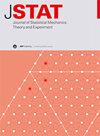Integrated modeling of crowd groups based on spatial distribution of members
IF 2.2
3区 物理与天体物理
Q2 MECHANICS
Journal of Statistical Mechanics: Theory and Experiment
Pub Date : 2024-07-02
DOI:10.1088/1742-5468/ad5712
引用次数: 0
Abstract
An integrated framework supporting both leader-follower and leaderless groups is proposed. The concept of subgroup is supported so that chains of groups can exist. This allows to model complicated group relationships in crowd simulations. To model group related dynamics, rules are proposed. A detailed explanation of implementation of these rules is given. To validate the proposed framework, two sets of numerical experiments are conducted, using experimental data collected by previous researchers. In one set of experiments, small leader-follower groups without subgroups are considered. In the other set, groups are leaderless and can be small or large with zero or more subgroups. The impact of crowd groups on fundamental diagrams is also experimented. The conducted experiments indicate that the proposed framework can reproduce results that are quite comparable to practical values, thus the framework’s efficacy is validated within a certain range.基于成员空间分布的人群群体综合建模
提出了一个支持领导者-追随者和无领导者群体的综合框架。支持子群的概念,因此可以存在群链。这样就可以在人群模拟中模拟复杂的群体关系。为了模拟与群体相关的动态,我们提出了一些规则。对这些规则的实施进行了详细说明。为了验证所提出的框架,我们利用之前研究人员收集的实验数据进行了两组数值实验。在一组实验中,考虑的是没有分组的小型领导者-追随者群体。在另一组实验中,群组是无领导的,可以是小群组,也可以是有零个或多个子群组的大群组。此外,还实验了人群组对基本图的影响。实验结果表明,提出的框架可以重现与实际值相当的结果,因此框架的有效性在一定范围内得到了验证。
本文章由计算机程序翻译,如有差异,请以英文原文为准。
求助全文
约1分钟内获得全文
求助全文
来源期刊
CiteScore
4.50
自引率
12.50%
发文量
210
审稿时长
1.0 months
期刊介绍:
JSTAT is targeted to a broad community interested in different aspects of statistical physics, which are roughly defined by the fields represented in the conferences called ''Statistical Physics''. Submissions from experimentalists working on all the topics which have some ''connection to statistical physics are also strongly encouraged.
The journal covers different topics which correspond to the following keyword sections.
1. Quantum statistical physics, condensed matter, integrable systems
Scientific Directors: Eduardo Fradkin and Giuseppe Mussardo
2. Classical statistical mechanics, equilibrium and non-equilibrium
Scientific Directors: David Mukamel, Matteo Marsili and Giuseppe Mussardo
3. Disordered systems, classical and quantum
Scientific Directors: Eduardo Fradkin and Riccardo Zecchina
4. Interdisciplinary statistical mechanics
Scientific Directors: Matteo Marsili and Riccardo Zecchina
5. Biological modelling and information
Scientific Directors: Matteo Marsili, William Bialek and Riccardo Zecchina

 求助内容:
求助内容: 应助结果提醒方式:
应助结果提醒方式:


